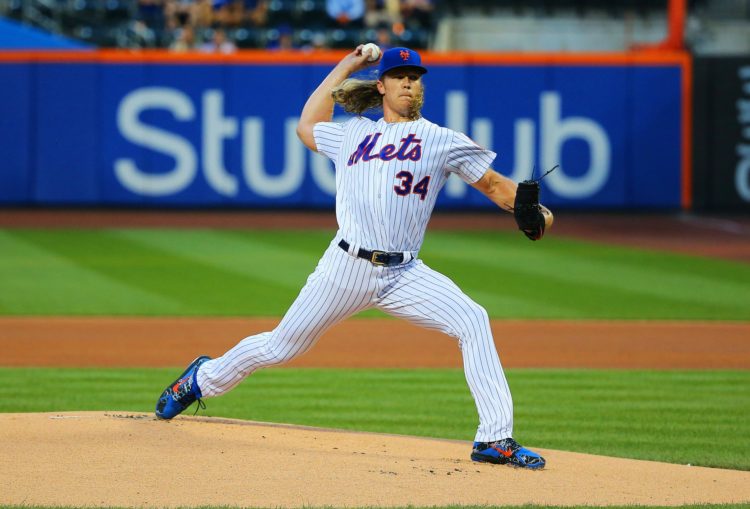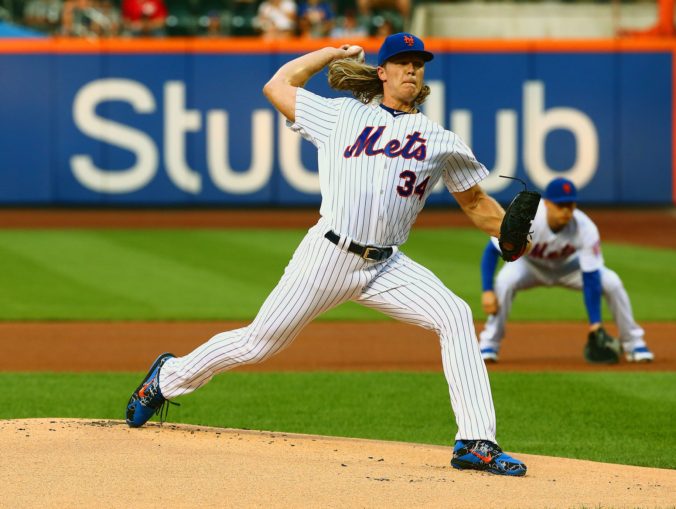
The New York Mets have aspirations of contending for a playoff spot in 2019. While certain parts of the roster must be overhauled prior to Opening Day next March, it seems like this team will ultimately go as far as the starting pitching can carry them.
And, basically, the majority of that pressure will land on the shoulders of Jacob deGrom (hopefully as the reigning National League Cy Young award winner), Noah Syndergaard, and Zack Wheeler. It’ll also be nice for the back end of the rotation to do its job, but without these three, it’ll be hard for New York to accomplish what they’re hoping for next season.
Each of these guys have done some great things on the mound in 2018, leaving each within an earshot of one another on season-long leaderboards. Among starting pitchers with at least 130 innings of work, they all fall within the top 20 with regard to fWAR, along with being in the top 10 when it comes to generating soft contact.
But what’s been the most effective pitch in their respective arsenals this year? We dug into the pitch type splits data on FranGraphs and used wRC+ against as the deciding factor when observing the three most-used pitches from each hurler in 2018.
Jacob deGrom
Any way you slice it, deGrom has put up video-game numbers through his career-high 209 innings of work this year, outside of that whole win-loss record. However, we all know there isn’t much more a dude can do for his team on the mound.
As one can imagine, virtually every kind of pitch thrown by deGrom has produced eye-popping numbers. He’s thrown his four-seam fastball, slider, and changeup at least 400 times each, which have yielded the following results with the final week of regular-season play ahead of us.
| 2018 | BB% | K% | OPS | ISO | GB% | SwStr% | wRC+ |
|---|---|---|---|---|---|---|---|
| Four-Seamer | 6.7% | 33.4% | .532 | .076 | 33.0% | 15.9% | 56 |
| Slider | 4.7% | 34.4% | .498 | .055 | 54.0% | 17.1% | 46 |
| Changeup | 1.6% | 31.5% | .375 | .081 | 62.7% | 17.6% | 8 |
The consistent dominance across the board here doesn’t get much better than this, and judging from last year, deGrom’s changeup has taken leaps and bounds in effectiveness. Hitters produced a 105 wRC+ against that offering in 2017, along with a .744 OPS and .189 ISO.
Just give the man his Cy Young now and get it over with.
Noah Syndergaard
If you asked Syndergaard about how his 2018 season has gone, he’d probably talk about how he’s mostly “wasting” his ability to throw a baseball. Even with those frustrations, he’s compiled a 12-4 record with a 3.36 ERA, and a soft-hit rate allowed (24.1%) that’s higher than his hard-hit rate allowed (22.1%).
We all know about Thor’s incredible slider velocity — his 92.0 mph average slider speed would be tops in baseball if he qualified for the ERA title — but it’s also clearly been his best overall pitch this year.
| 2018 | BB% | K% | OPS | ISO | GB% | SwStr% | wRC+ |
|---|---|---|---|---|---|---|---|
| Sinker | 8.3% | 16.1% | .780 | .128 | 54.0% | 6.9% | 123 |
| Four-Seamer | 8.5% | 14.0% | .803 | .157 | 35.8% | 6.0% | 129 |
| Slider | 1.6% | 41.6% | .484 | .034 | 48.6% | 24.9% | 39 |
Syndergaard’s slider has consistently been his most effective offering from a wRC+ standpoint throughout his big-league career, but what caught my eye more were the numbers his four-seam fastball produced.
Since 2017 was basically a lost season, we’ll throw that production out. In 2015 and 2016, though, opposing hitters produced an 87 and 97 wRC+ against that pitch, respectively. His swinging-strike rate in that situation also never dipped below 9.1% during that time prior to dipping significantly this year. After easily posting a positive pitch value for his fastball overall between 2015 and 2016, it’s fallen to the negative side over the past two seasons.
Getting his fastball back in check will only help the rest of his arsenal, which all dropped with regard to FanGraphs’ pitch value this year — both compared to last year’s small sample size and the year prior.
Zack Wheeler
This has been quite the year for Wheeler. He’s gone from starting 2018 as part of the Triple-A starting rotation to ending it as a crucial piece of the big-league unit moving into the immediate future. A lot had been made — and rightfully so considering his injury history — about the right-hander’s resurgent fastball velocity (95.9 mph). However, he only threw fastballs at a 58.2% clip, which is a single-season career low.
That didn’t stop his two-seamer from making a huge jump from last year to now.
| 2018 | BB% | K% | OPS | ISO | GB% | SwStr% | wRC+ |
|---|---|---|---|---|---|---|---|
| Four-Seamer | 8.5% | 23.6% | .674 | .099 | 38.0% | 9.8% | 96 |
| Slider | 5.1% | 21.9% | .537 | .078 | 55.1% | 11.8% | 58 |
| Two-Seamer | 3.6% | 15.3% | .511 | .099 | 58.3% | 7.8% | 42 |
In 2017, hitters posted a 174 wRC+ off Wheeler’s two-seamer, which led to a .342/.427/.579, 12.4% walk rate, and 13.5% strikeout rate. This literally went from his worst pitch to his best pitch when using wRC+ as the barometer.
These improvements were part of the reason behind the 28-year-old’s breakout season. His 4.2 fWAR through 182.1 innings more than doubled his career total entering 2018 (3.8 fWAR through 371.2 innings). The Mets only paid him $1.9 million this season, but according to FanGraphs’ Dollars metric, Wheeler’s performance was worth $33.2 million. It’s safe to say he’ll get a nice raise in his final year of arbitration.
Moving Forward
Does this tell us much about New York’s top three starting pitchers? Kinda, but not really. It just helps put their individual performances in perspective heading into the winter. The most important part for 2019 — which sounds like a broken record at this point — is having them all on the mound for an entire season.
With two consecutive campaigns of 200-plus innings under his belt, deGrom appears primed to continue leading the way, while Wheeler threw enough frames to give himself a chance to reach that range next year. Syndergaard was the x-factor after throwing just north of 30 innings in 2017, but he’ll at least be approaching the 150-inning plateau by the time Game 162 is in the books.
There will be lots of things different about the Mets next season — no David Wright, a new general manager, and hopefully a roster that truly reflects the team’s desires to reach October. One thing that won’t, though, is New York’s dependency on the starting rotation’s performance, and more specifically, the three hurlers we just talked about.















